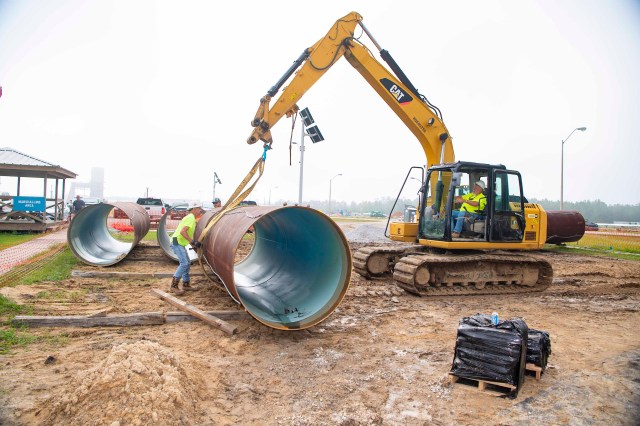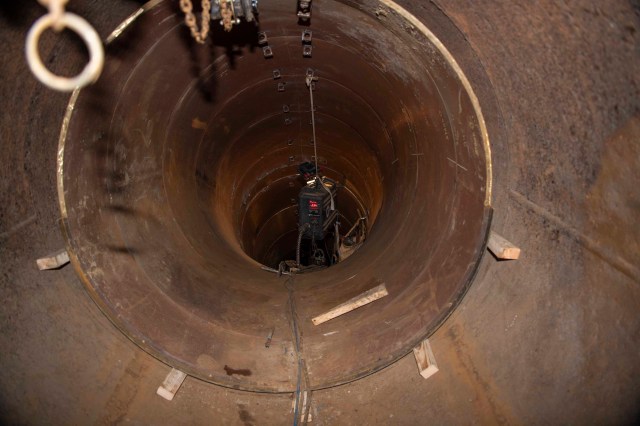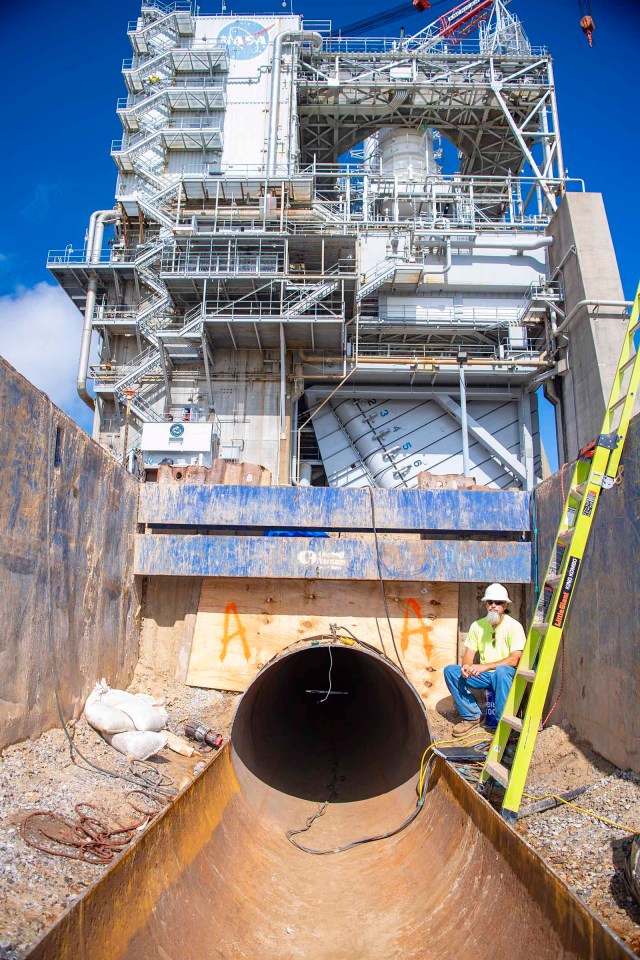Crews prepare new pipeline liner sections for installation near the Fred Haise Test Stand on May 1 in the last phase of updating the original test complex industrial water system at NASA’s Stennis Space Center.
NASA/Danny Nowlin
Crews are using an innovative engineering approach to upgrade an essential test complex water system that will help ensure the future of large propulsion testing at NASA’s Stennis Space Center near Bay St. Louis, Mississippi.
“It is a critical facility and a critical pipeline system because testing does not happen without having a way to supply water to the test stands,” said NASA project manager Casey Wheeler. “With this project, we are basically resetting the clock on the older piping that was originally installed back when the site was built in the 1960s.”
The last phase of updating the original test complex water pipeline system began shortly after NASA completed a successful RS-25 engine test campaign in April on the Fred Haise Test Stand.
Approximately 5 million gallons of water is delivered from the High Pressure Industrial Water Facility to the Fred Haise Test Stand (formerly A-1 Test Stand) during a 500-second RS-25 test. The water travels through a quarter mile of piping that starts at 75 inches in diameter and reduces to 66 inches before entering the test stand.

Crews lift a new pipeline liner section near the Fred Haise Test Stand on May 1 in the last phase of updating the original test complex water system at NASA’s Stennis Space Center.
NASA/Danny Nowlin

An image shows a new pipeline liner section being place inside the existing carrier pipe near the Fred Haise Test Stand on May 1 in the last phase of updating the original test complex industrial water system at NASA’s Stennis Space Center.
NASA/Danny Nowlin

Crews use a special tool to place a new pipeline liner section inside the existing carrier pipe near the Fred Haise Test Stand on May 1 in the last phase of updating the original test complex industrial water system at NASA’s Stennis Space Center.
NASA/Danny Nowlin

An image shows the entry location of the existing carrier pipe where new liner sections are being placed at the base of the Fred Haise Test Stand at NASA’s Stennis Space Center in the last phase of updating the original test complex industrial water system.
NASA/Danny Nowlin

Crews use a special tool to place a new pipeline liner inside the existing carrier pipe near the Fred Haise Test Stand on May 1 in the last phase of updating the original test complex industrial water system at NASA’s Stennis Space Center.
NASA/Danny Nowlin

An aerial view shows the pipeline liner installation area at the base of the Fred Haise Test Stand on May 1 where crews are in the last phase of updating the original test complex industrial water system at NASA’s Stennis Space Center.
NASA/Danny Nowlin

Crews prepare new pipeline liner sections for installation near the Fred Haise Test Stand on May 1 in the last phase of updating the original test complex industrial water system at NASA’s Stennis Space Center.
NASA/Danny Nowlin
Crews previously upgraded piping to the Thad Cochran Test Stand at NASA Stennis, as well as some sections within the A Test Complex. However, the piping leading to the Fred Haise Test Stand posed a particular challenge because of its deep underground placement and the existing utilities nearby. The uncommon approach crews are taking to renew the life of this section involves installing a steel liner inside the existing steel pipe.
The team dug down into a top section of pipe that was easier to access. After cutting the top half of the pipe off, crews could see inside it. They now are lowering new sections of pipe inside the existing pipe and using a carrier to roll the sections into their final location.
As new sections are rolled into place, welders inside the pipe are connecting each individual liner section to make one continuous pipeline within the original piping.
“It is relatively unconventional in the overall scheme of how pipeline construction goes,” Wheeler said. “Typically, whenever you are building a new pipeline or replacing an existing one, you are running a whole new pipeline route.”
The current phase of the project, scheduled around the RS-25 test schedule since it involved a water outage and draining the pipes, is on pace to be completed by the end of the summer. Once the water system is activated, crews will check the system and water flow to each of the test stands.
The project is being carried out by a team from NASA; Syncom Space Services, the prime contractor for site facilities and operation; and Healtheon, Inc., the NASA-direct construction contractor.
“Our teamwork is a reason we have been able to make this project successful, and we are on the path of successfully completing it,” Wheeler said. “The credit goes collectively to our whole team for making sure all these pieces are pulled together in an orderly manner to make the project successful.”

